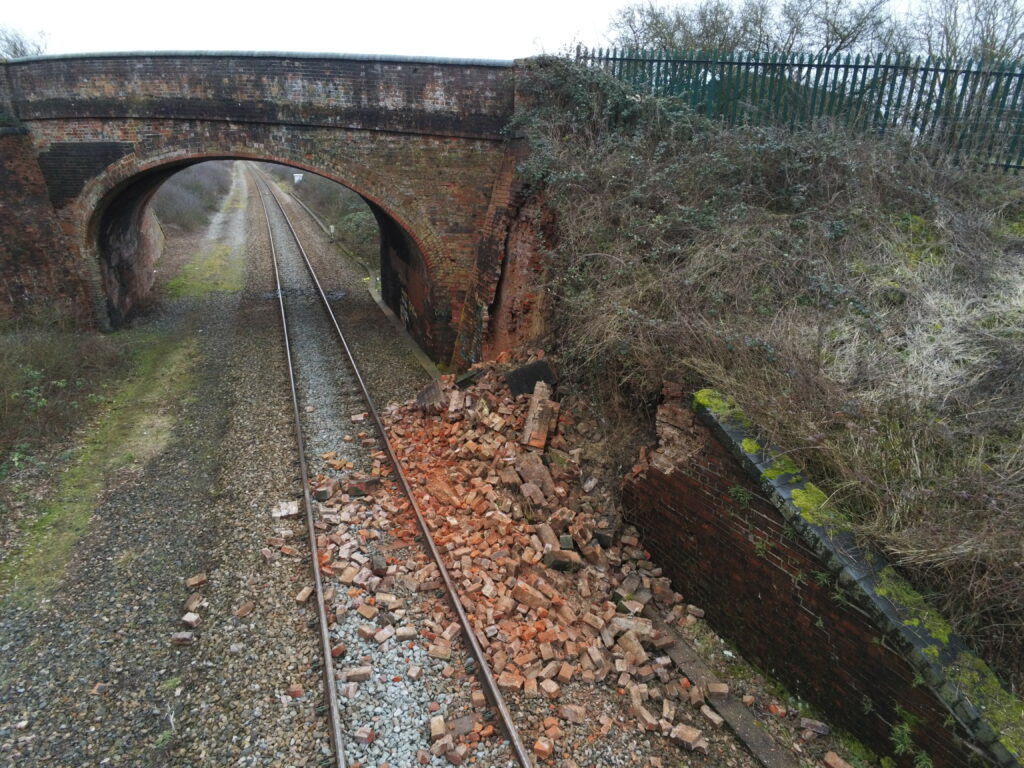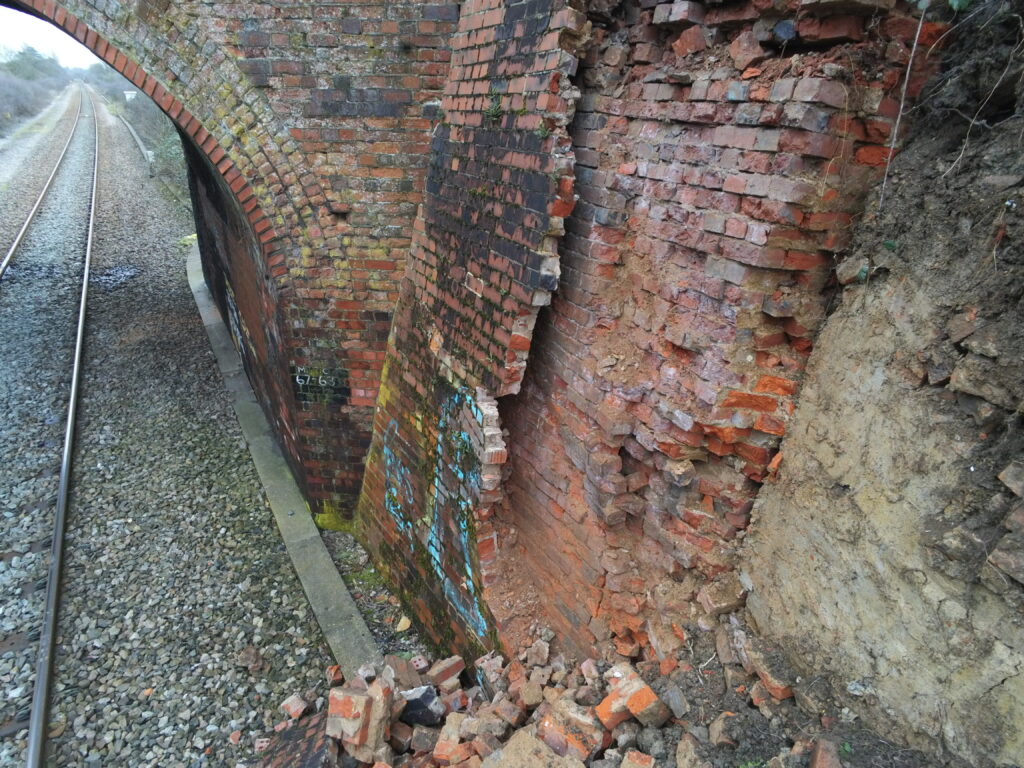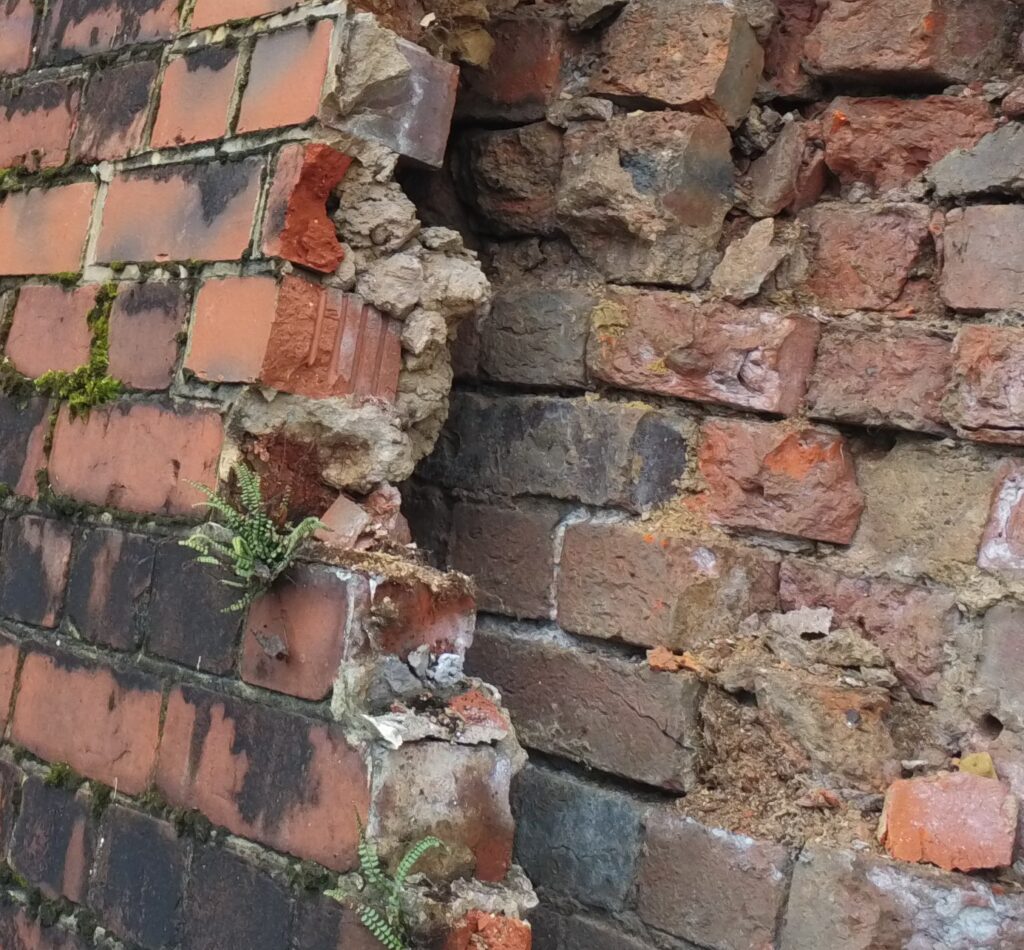As is often the way with incidents and accidents, it is not one failure alone that is the cause but a series of isolated factors which can together conspire to lead to an unhappy outcome. This was certainly so in the case of a collapsed wing wall which was then struck by a train at Yarnton. The Rail Accident Investigation Branch (RAIB) has recently published its report into the circumstances and causes of the collision. It is not the intention of this article to paraphrase the RAIB report. Rather it is to inform structural examiners, examining engineers, asset managers, and maintenance contractors of the findings and lessons learnt from the incident, which potentially have system wide implications.
The incident
The incident occurred in the early evening of 10 February 2023 at Yarnton, on the Oxford to Worcester line. Forward facing camera images from two recent trains showed the wall still standing, and a third train passed the site safely 19 minutes before the incident. At 18:35, the 17:34 Great Western Railway service from London Paddington to Hereford made an emergency brake application after striking fallen debris from the collapsed wall. Fortunately, there were no injuries to passengers or train staff and the train did not derail, but the incident resulted in damage to the train, preventing the completion of its journey.
The line remained closed while checks were carried out, but after reopening it had to be closed again after further ground movement of the slope above the remains of the wall. It remained closed for several days until the completion of extensive work to stabilise the slope. The incident also necessitated closure of the roadway above for some time until it reopened with single lane working on 28 February.
Hidden defects

The wing wall in question formed part of a heavily skewed road over rail bridge. It is of an unremarkable type, in brickwork, similar to many other structures dating from the original construction of the railway. Unfortunately, though, for those now responsible for its inspection and maintenance, it had acquired hidden defects.
Owing to the skewed nature of this overbridge, the wing wall is formed in elevation as a long triangle, 13 metres in length and 5.3 metres in height, supporting a considerable extent of the road embankment. Throughout many years of examination, bulging of the wing wall and drummy areas of brickwork had been noted and monitored in some detail. Eventually this had led to a recommendation that repairs could no longer be postponed and this was budgeted for and was carried out in 2013. The specification was to ‘pin and grout’ throughout the areas of bulging with the aim of arresting any further outward movement of the wall and to ensure that structural support of the embankment was guaranteed.
Most unfortunately, because no record drawings existed from the original construction of the wall and neither of any subsequent work which might have been carried out to it, the internal circumstances and condition of the wall were unknown. That is, until after the collapse of the wall in February 2023, when the dangerous condition of the wall was revealed.
At some unknown date in the distant past a second skin of brickwork had been built in front of the original wall, presumably as an attempt to strengthen it in response to signs of distress. However, this second wall was found to have not been bonded into the original wall as would be expected. It was merely a facing, 100mm deep, a single brick thickness, and, as seen externally, apparently with header bricks to tie into the original wall. But these bricks were only half-bricks, known as ‘snap headers’ and they made no effective bond with the original wall. Adding insult to injury, there was also found to be a 100mm void between the two walls. Not only did the second outer wall fail to add any strength to the original wall, but it also masked the hidden ongoing deterioration of the inner wall. Furthermore, regarding the actual collapse, it contributed a considerable additional volume of debris brought down onto the track, worsening the scale of the collision.
Because of the void between the two walls, the pinning and grouting work in 2013 would have been ineffective, with the majority of the grout falling into the void and achieving no bonding contribution. This became another ‘hidden defect’, in that asset engineers put more faith in this repair than it deserved and possibly led to their assigning higher scores in condition marking than was warranted.
Structural examinations
The wing wall (as had all the other structural elements of the overbridge) had been subject to the standard routine regime of examinations, receiving detailed reports every three years and intermediate annual visual examinations.
In the 10-year interval between the 2013 minor pin and grout works and the collapse in 2023, the examination reports drew attention to ongoing deterioration with the bulging of the wall and the drummy areas of brickwork remaining of concern. However, it was not easy for examiners to make successful and accurate comparisons of deterioration between one detailed examination and the next. For example, a recommendation following the 2014 detailed examination report was made by the examining engineer to “Rake out fractures to sound material, point in and apply tabs to monitor for movement at future examinations.”

This recommendation applied to several areas of the bridge, but included the south-west wing wall, the wall which collapsed. It appears that the tabs were never actually installed. Also, while photographic records of the bulging and fractures were used at successive examinations, the angles from which the images were taken were not consistent and were of a low resolution, making deterioration difficult to judge. Network Rail now has a revised standard which specifies the requirement for high resolution images.
With a lack of any quantitative measurements of the amount of bulging and comments on successive detailed examination reports such as “…appears to be no visual change” and “…similar condition to the last exam. No new major defects and no worsening of existing defects,” the asset engineers would have had confidence that the 2013 repair had stabilised the wall. More detailed measurements would probably have led to recommendations to investigate the bulging and would have discovered the void between the original structural wall and the skin wall.
Ironically, the final visual examination in January 2023, three weeks before the collapse, did note from comparison of photographs while on site that the bulging appeared to have increased and that there was deterioration throughout the wing wall. However, these observations, were not deemed serious enough to immediately notify the asset engineer and this latest report was still under review by the examining engineer at the time of the collapse.
Risk assessment
Network Rail has a company standard setting out the requirements for bridge condition marking so that each structure can be given a unique measurable score using the Bridge Condition Marking Index (BCMI). A score of 100 means that the structure is in perfect condition, whereas a score of 40 or less would normally trigger detailed examinations at a more frequent interval. Yarnton Road bridge had an overall BCMI score of 28 and the south-west wing wall had a score of 20.
There is also a risk assessment system to assist in the prioritisation of structural repair to an identified defect by assigning it a risk score. The score is the examining engineer’s judgment of the overall risk remaining should the defect not be rectified within one year. The score is derived from a 5 x 5 matrix to which severity factors are attributed for likelihood of a failure and the consequences should that occur, up to a maximum possible score of 25.
A risk score of 12 or more would normally lead to planning of remedial work. Following the 2014 and 2018 detailed examinations, risk scores of six and eight respectively were given. The slight increase in the later score was probably because the 2014 report noted that fractures to the wing walls had been pinned and grouted, but the 2018 report noted that no evidence of this could be found and also that the majority of the fractures were open.
The RAIB report suggests that the severity of consequence was underscored in both years and that this was possibly a result of scoring the structure as a whole rather than the wing wall specifically. Higher scores would possibly have led to remedial work being planned much earlier.
Planned remedial works

Yarnton Road bridge’s low BCMI score and its poor condition did lead to it being proposed for major repair work in 2014 which was given a provisional start date of 2019/2020. In May 2019, that was changed to 2022/2023. This was again later changed to 2023/2024 due to resourcing limitations.
The scope of works proposed was to rectify defects identified in the most recent detailed and visual examination reports, particularly addressing the wing walls which were in poor condition throughout, with bulging, numerous fractures, spalled bricks, and drummy areas. There would be stitching across fractures and tying back bulging areas to sound material, all with the aim of achieving a theoretical BCMI score of 58.
Significant structural strengthening was not proposed at this stage, but that monitoring points would be put in after the repairs. If these showed ongoing movement was taking place, then work such as ground anchors or a reinforced concrete facing would be considered as the next intervention.
In January 2023, Network Rail rescoped the renewal programme because of insufficient budget. The Yarnton Road project was moved back to a provisional date of 2029. However, this was only a holding date pending completion of a deferred renewal risk assessment to justify the deferral. The risk assessment had not yet been done and the results might have indicated that an earlier date was needed. The RAIB report also comments that even had the work been done, the scope of that work is unlikely to have been adequate to have prevented the failure. This would only have been possible with the full knowledge of the internal condition of the wall and the specification of appropriate and more substantial remedial work, such as that outlined above.
Post-incident checks
The other three wing walls at Yarnton Road were checked by drilling core holes. No other voids were found. However, another similar bridge not far away with bulges and fractures was found to have voids in all four wing walls. A temporary speed restriction was imposed until remedial works had been completed.
Summary
In conclusion, the RAIB report identifies four Recommendations and four Learning Points and makes some other observations.
Full details can be found in report No.1/2024 at: www.gov.uk/raib-reports/report-01-slash-2024-train-striking-debris-at-yarnton.
Lead image credit: RAIB

